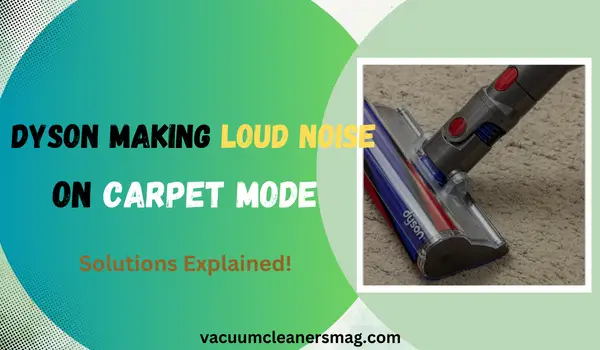Introduction to the issue
Dyson vacuum cleaners have long been lauded for their advanced technology and efficient cleaning capabilities. However, a pressing issue has emerged that demands attention: the unsettling occurrence of Dyson vacuums emitting unusually loud noises while in carpet mode. This problem, aptly summarized as Dyson making loud noise in carpet mode, has become a cause of concern for users who rely on the brand’s reputation for a seamless cleaning experience.
Carpet mode is designed to thoroughly clean carpets, ideally without causing disruption or undue noise.
Regrettably, increasing users have reported encountering an intrusive noise that hampers the cleaning process and raises questions about the vacuum’s overall functionality.
Whether stemming from motor irregularities, brush roll complications, or other underlying factors, understanding the origin of this issue is crucial.
This article explores the root causes behind the disturbing noise, offering insights into potential solutions and necessary steps to mitigate the problem.

Understanding the mechanics of Dyson vacuums
Dyson vacuums are renowned for their innovative engineering, which sets them apart in the cleaning appliance market. These devices operate on a cyclonic suction principle, leveraging powerful airflow to capture dirt and debris efficiently. The vacuum’s main components include a motor, cyclone assembly, filter system, and cleaning head with brush roll.
In the context of carpet mode, Dyson vacuums are designed to adapt to different surfaces. When switched to carpet mode, the vacuum adjusts its suction power and brush roll rotation to clean carpets effectively. The brush roll agitates the carpet fibres, loosening embedded dirt, which is then drawn into the vacuum by the strong suction.
However, loud noise in carpet mode suggests a potential issue within this intricate system. The noise could originate from irregularities in the motor’s operation, leading to vibrations and disturbances. Alternatively, the brush roll might encounter resistance due to obstructions or improper alignment, resulting in noise during rotation.
Addressing the noise concern requires a comprehensive understanding of these mechanisms, enabling users to diagnose and rectify specific issues.
Common Causes of Loud Noises on Carpet in Vacuum Cleaners
Loud noises in vacuum cleaners can stem from various underlying issues within the machine’s intricate components. These disturbances can be disruptive and indicate potential problems that require attention. Common causes of loud noises include:
Motor Irregularities:
A malfunctioning or damaged motor can emit loud noises as it struggles to operate. Bearings within the motor might wear out, causing vibrations and noisy operation.
Brush Roll Issues:
Misaligned or damaged brush rolls can create a loud clattering or grinding noise when they make contact with the floor. Debris or tangled fibers can impede smooth rotation.
Clogging in the Suction Pathway:
Obstructions in the vacuum’s suction pathway, such as trapped debris or blockages, can disrupt airflow, causing the motor to strain and generate loud noises.
Loose Components:
Vibrations from loose screws, bolts, or other internal components can create rattling or banging noises during operation.
Fan Problems:
If the fan blades are damaged, unbalanced, or encountering resistance, they can generate a distinctive loud noise as they spin.
Belt Issues:
In vacuums with belts, a worn-out or misaligned belt can cause a screeching noise, especially when transitioning from one surface to another.
Foreign Objects:
Items inadvertently sucked into the vacuum, like coins or small toys, can rattle inside the machine and produce noise.
Worn Bearings:
Bearings in various moving parts of the vacuum, including the brush roll and motor, can wear out over time, resulting in friction-related noise.
Exhaust Blockages:
Blockages in the exhaust or filter area can lead to improper airflow, causing the motor to strain and generate noise.
Lack of Lubrication:
Some parts of the vacuum, like motor bearings, may require lubrication. Insufficient lubrication can lead to increased friction and noise.
Identifying the specific cause of the loud noise is essential for effective troubleshooting and resolution. Regular maintenance, cleaning, and adherence to manufacturer guidelines can help prevent many of these issues and extend the vacuum’s lifespan while ensuring quieter operation.
Troubleshooting and solutions
Troubleshooting loud noise issues in a vacuum cleaner requires a systematic approach to identify and address the underlying causes. Here’s a step-by-step guide to help you diagnose and resolve the problem:
Power Off and Unplug:
Before proceeding, ensure the vacuum cleaner is powered off and unplugged to prevent any accidents during inspection and maintenance.
Check for Obstructions:
- Examine the brush roll area, nozzle, hose, and attachments for any lodged debris or foreign objects.
- Remove obstructions carefully using gloved hands, pliers, or a straightened coat hanger.
Inspect the Brush Roll:
- Turn the vacuum upside down to access the brush roll.
- Examine the brush roll for tangled hair, fibers, or debris hindering its rotation.
- Use scissors or a seam ripper to remove entangled materials carefully.
Motor Examination:
- Look for loose screws, bolts, or components around the motor area.
- Turn the vacuum on (if safe) and listen for any unusual sounds from the motor.
- If the motor emits excessive noise, it might require professional attention.
Fan and Exhaust Inspection:
- Check the fan blades for damage or debris. Clean if necessary.
- Ensure that the exhaust area and filters are free from clogs and blockages.
Belt Assessment (If Applicable):
- If your vacuum has belts, inspect them for wear and proper alignment.
- Replace worn or damaged belts according to the manufacturer’s recommendations.
Check for Loose Components:
- Gently shake the vacuum to listen for any rattling noises, which could indicate loose parts.
- Tighten any loose screws or components using appropriate tools.
Test on Different Surfaces:
- Run the vacuum on various surfaces, including carpets and hard floors, to determine if the noise persists across all settings.
Professional Servicing:
- If you cannot identify or resolve the issue, consider taking the vacuum to an authorized service center for professional diagnosis and repair.
Remember to prioritize safety throughout the troubleshooting process. Regular maintenance, such as cleaning filters, emptying dustbins, and checking for obstructions, can help prevent future noise problems. Following these steps and adhering to manufacturer guidelines can effectively address the loud noise issue and ensure your vacuum’s optimal performance.
Preventive Measures to Avoid Future Issues
Taking proactive steps to maintain your vacuum cleaner can significantly reduce the likelihood of encountering loud noise issues and extend the appliance’s lifespan. Here are some preventive measures to consider:
Regular Cleaning:
Empty the dustbin or collection bag after each use to prevent clogs and maintain optimal suction.Clean or replace filters as recommended by the manufacturer to ensure efficient airflow.
Brush Roll Maintenance:
Check the brush roll regularly for tangled hair, fibers, and debris. Remove any obstructions to prevent noise and maintain effective cleaning.
Inspect and Tighten:
Periodically inspect the vacuum for loose screws, bolts, and components. Tighten them if necessary to prevent vibrations and noise.
Proper Use:
Use the vacuum according to the manufacturer’s guidelines. Avoid using it on unsuitable surfaces, as this can strain the motor and cause noise.
Adjust for Surfaces:
If your vacuum has adjustable settings for different surfaces, use the appropriate setting to avoid unnecessary strain and noise.
Avoid Large Debris:
Refrain from vacuuming up large or hard objects that can damage the brush roll or motor.
Store Properly:
Store the vacuum in a dry, cool place to prevent exposure to extreme temperatures or humidity that could degrade its components.
These preventive measures can maintain your vacuum’s functionality and minimize the risk of encountering loud noise issues. Regular care ensures quieter operation and enhances your vacuum cleaner’s overall cleaning efficiency and longevity.
Conclusion
In the home cleaning, Dyson is a paragon of innovation and quality. Yet, the issue of Dyson making loud noise in carpet mode disrupts this reputation. This concern necessitates a closer look at the mechanics.
Understanding sources like motor irregularities, brush roll problems, and clogs empowers effective troubleshooting. Users can prevent future disruptions by embracing proactive maintenance and adhering to usage guidelines.
As Dyson enthusiasts address noise challenges head-on, they ensure a tranquil and efficient cleaning experience, preserving the brand’s legacy of excellence.

Hi Everyone.
I’m Safeer. I always loved trying out the latest cleaning and home products and sharing my thoughts about those products with you awesome people. Whether it’s related to general cleaning or it includes cleaning with high-tech vacuum cleaners, I always test them myself and then share valuable opinions with you. Additionally, I also let you know how to resolve particular issues of vacuum cleaners. To look for detailed reviews and troubleshooting tips about vacuum cleaners VaccumCleanersMag is the perfect abode for you.